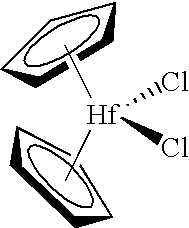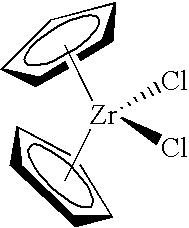Organometal catalyst compositions
a technology of organic compounds and compositions, applied in the direction of catalyst activation/preparation, physical/chemical process catalysts, chemical/physical processes, etc., can solve the problems of large amounts of expensive methyl aluminoxane, low productivity, and inability to commercializ
- Summary
- Abstract
- Description
- Claims
- Application Information
AI Technical Summary
Problems solved by technology
Method used
Image
Examples
example 1 (
Silica)
A 0.5686 gram sample of silica calcined per the procedure discussed previously was charged to the reactor for polymerization tests. Two milliliters of 1.0 molar triethylaluminum were added to the reactor along with 2 milliliters of 0.5 weight percent bis(n-butylcyclopentadienyl)zirconium dichloride. During a polymerization run of 63.0 minutes, 0.65 grams of polymer were produced yielding an activity of 1 gram of polymer per gram of silica per hour.
example 2 (
A 0.2361 gram sample of alumina calcined per the procedure discussed previously was charged to the reactor for polymerization tests. Two milliliters of 1.0 molar triethylaluminum were added along with 2 milliliters of 0.5 weight percent bis(n-butylcyclopentadienyl)zirconium dichloride. During a polymerization run of 60.9 minutes, 6.9 grams of polymer were produced yielding an activity of 29 grams of polymer per gram of alumina per hour.
example 3 (
Chlorided Alumina)
Ten grams of Ketjen grade B alumina were calcined in air for three hours at 600° C. as described previously. After calcining, the furnace temperature was maintained at 600° C., and the gas stream was changed from air to dry nitrogen. Then, 2.3 milliliters of carbon tetrachloride were injected into the nitrogen stream and evaporated upstream from the alumina bed. The carbon tetrachloride vapor was carried up through the bed and reacted with the alumina to produce a chlorided alumina. The chlorided alumina was white in color.
A sample of the chlorided alumina, weighing 0.2058 grams, was then charged to the reactor for polymerization tests. Two milliliters of 1.0 molar triethylaluminum were added along with 2 milliliters of 0.5 percent bis(n-butylcyclopentadienyl)zirconium dichloride. During a polymerization run of 63.0 minutes, 351.5 grams of polymer were produced yielding an activity of 1627 grams of polymer per gram of chlorided alumina per hour.
PUM
| Property | Measurement | Unit |
|---|---|---|
| Temperature | aaaaa | aaaaa |
| Temperature | aaaaa | aaaaa |
| Temperature | aaaaa | aaaaa |
Abstract
Description
Claims
Application Information
 Login to View More
Login to View More - R&D
- Intellectual Property
- Life Sciences
- Materials
- Tech Scout
- Unparalleled Data Quality
- Higher Quality Content
- 60% Fewer Hallucinations
Browse by: Latest US Patents, China's latest patents, Technical Efficacy Thesaurus, Application Domain, Technology Topic, Popular Technical Reports.
© 2025 PatSnap. All rights reserved.Legal|Privacy policy|Modern Slavery Act Transparency Statement|Sitemap|About US| Contact US: help@patsnap.com



